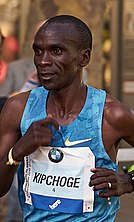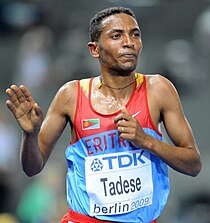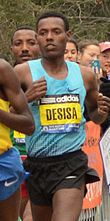 Eliud Kipchoge |
 Zersenay Tadese |
 Lelisa Desisa |
Breaking2 was a project by Nike to break the two-hour barrier for the marathon. Nike announced the project in November 2016 and organized a team of three elite runners who trained for a private race. The event was held on the Formula One race track Autodromo Nazionale di Monza in Italy on May 6, 2017.[1][2][3][4]
Eliud Kipchoge won the race with a time of 2:00:25.[5] While the world record at the time was 2:02:57, this run was not recognized as a new record, because Kipchoge and the other two elite athletes ran with a roster of interchangeable pacemakers.[6]
Team members edit
Nike chose three runners to make the attempt:[4][7]
| Name | Nationality | Birth date | Age | Previous best marathon |
|---|---|---|---|---|
| Lelisa Desisa | Ethiopia | 14 January 1990 | 27 | 2:04:45 |
| Eliud Kipchoge | Kenya | 5 November 1984 | 32 | 2:03:05 |
| Zersenay Tadese | Eritrea | 8 February 1982 | 35 | 2:10:41 |
At the time, Kipchoge was the defending Olympic champion, having won the marathon at the 2016 Summer Olympics in Rio de Janeiro, and Zersenay was the half marathon WR holder (58:23, set in 2010).
Nike also brought in 30 of the world's best runners to serve as pacers for the race, including Andrew Bumbalough, Sam Chelanga, Chris Derrick, Bernard Lagat, and Lopez Lomong.[7][8]
Preparations edit
Nike developed a new running shoe called the "Vaporfly Elite" for the attempt.[9] The Monza automobile racetrack was chosen for a combination of its low altitude, calm weather conditions, and short lap length. In addition to the pacemaker vehicle, runners acting as pacemakers were positioned to shield the key athletes in an attempt to reduce wind resistance.[10]
Race edit
The race began at 5:45 am on Saturday, May 6, 2017, with a temperature of 12°C or 54°F (a higher than ideal temperature for professional marathoners, generally[11]) and some light rain.
To break the two-hour barrier, a pace of 2:50 min/km (4:34.5 per mile) was required. In order to achieve this, the racers followed behind a team of six pacers in a triangle formation who were themselves following a pace vehicle displaying a large clock of the race time and projecting green lasers onto the ground to indicate where the lead pacer should be at all times. The pacers only ran two laps (4.8 km) at a time and had 30 minute breaks in between shifts. Groups of pacers would cycle on and off in threes.[8] These innovations disqualified the performances from being recognised as official marathon records by the IAAF.[6]
The runners started off on pace, but Desisa fell off the pace about 16km in, and Tadese followed around 20km. Kipchoge remained on pace through 25km (at 1:11:03) and was only one second off pace at 30km. Kipchoge finished the race in 2:00:25 and said he had given 100 percent effort.[7]
Results edit
| Position | Athlete | Nationality | Time |
|---|---|---|---|
| Eliud Kipchoge | Kenya | 2:00:25 | |
| Zersenay Tadese | Eritrea | 2:06:51 | |
| Lelisa Desisa | Ethiopia | 2:14:10 |
At the time of the race, the world record of the marathon was 2:02:57 (set by Dennis Kimetto at the 2014 Berlin Marathon). Even though Kipchoge beat this time by more than two minutes, his result does not count as an official record by IAAF standards because of several factors, including the use of pacers who entered the race midway.[12]
Aftermath edit
Documentary edit
A 55-minute documentary about the event also called Breaking2 was produced in partnership with National Geographic and released in 2017.[13][14]
Subsequent successful attempt edit
In 2019, Kipchoge participated in the Ineos 1:59 Challenge, another attempt to break the two-hour mark. The attempt was ultimately successful as Kipchoge finished with a time of 1:59:40.2, but the time did not count as a world record because, like Breaking2, the setup of the event did not conform to the IAAF's requirements.
References edit
- ^ Ed Caesar (12 December 2016). "Inside Nike's Quest for the Impossible: a Two-Hour Marathon". Wired. Retrieved 12 May 2017.
- ^ Alex Hutchinson (12 December 2016). "Nike's Audacious Plan: Break the 2-Hour Marathon Barrier in 2017". Runner's World. Retrieved 12 May 2017.
- ^ Ross Tucker, Ph.D. (12 December 2016). "The sub-2 hour marathon in 2017? Thoughts on concept". The Science of Sport. Retrieved 12 May 2017.
- ^ a b "Interactive: A look at how three marathoners could break the sub-2hr barrier on May 6". The Straits Times. Retrieved 12 May 2017.
- ^ Jon Mulkeen (6 May 2017). "Kipchoge a 'happy man' in Monza". IAAF. Retrieved 12 May 2017.
- ^ a b Caeser, Ed (6 May 2017). "Nike's Quest to Beat the Two-Hour Marathon Comes Up Oh So Short". Wired. Wired. Retrieved 9 February 2020.
- ^ a b c Nolan, Ali (6 May 2017). "So Close! Kipchoge Runs a 2:00:25 in the Breaking2 Attempt". Runner's World. Retrieved 12 May 2017.
- ^ a b Strout, Erin (9 May 2017). "What It Was Like to Pace the Fastest Marathon in History". Runner's World. Retrieved 12 May 2017.
- ^ "Nike Zoom VaporFly Elite: the shoe of Breaking2 you can't buy". www.runningshoesguru.com. Retrieved 2017-11-29.
- ^ Matt Burgess, 10 May 2017 "If you missed Nike's two-hour marathon attempt you can relive it here" wired.co.uk
- ^ "Can the marathon's two-hour barrier be broken?". Economist. 2017-10-04. Retrieved 2018-10-01.
- ^ Buzacott-Speer, Eliza (6 May 2017). "Eliud Kipchoge falls 26 seconds short of first sub two-hour marathon". Australian Broadcasting Corporation. Retrieved 12 May 2017.
- ^ "Watch the Epic Quest to Run a Marathon in Less Than 2 Hours". Travel. 2017-09-29. Archived from the original on May 17, 2021. Retrieved 2022-09-29.
- ^ Nike News (6 May 2017). "Nike Celebrates its Breaking2 Results". Nike. Retrieved 1 September 2017.
External links edit
- Nike Introduces Breaking2 December 12, 2016